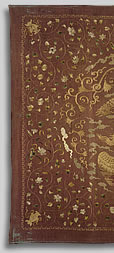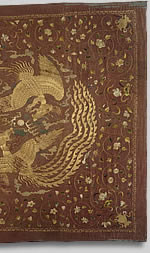Canopy with Phoenixes
China, Yuan dynasty (1271–1368)
Embroidery, silk and gold thread
The Metropolitan Museum of Art, New York, Purchase, Amalia Lacroze
de Fortabat Gift, Louis V. Bell and Rogers Funds, and Lita Annenberg
Hazen Charitable Trust Gift, in honor of Ambassador Walter H. Annenberg,
1988 (1988.82)
cat. 184
© 1996 The Metropolitan Museum
of Art, New York
[click images for full object view] |
 |
 |


